Recorded crime in Scotland: handling offensive weapons
This report presents information on handling offensive weapons recorded by the police.
3. Characteristics of Weapons Crime in Scotland
Introduction
This section presents the findings of research into the characteristics of handling offensive weapons in Scotland. The research was based on a review of 1,500 randomly selected crimes recorded by the police between April to September in 2013 and 2017.
Methods
Scottish Government statisticians randomly selected a large sample of crime records from the ‘Handling Offensive Weapons’ category. With facilitative support and advice from Police Scotland they then reviewed the case notes for each crime sampled, to collect a range of information. This included perpetrator characteristics and the types of weapons they handled, and where relevant who they targeted with those weapons. No personal or sensitive details (names, dates of birth etc.) were collected.
These records were sampled from the first six months (April to September) of two different reporting years. The breakdown of the full 1,500 sample is shown below ( Table 1). The sample and the findings drawn from it are also split into crimes where the weapon was not used in a public setting to commit another crime or offence against a person (henceforth referred to as ‘not used in other criminal activity’) and crimes where the weapon was used in a public setting to commit another crime or offence against a person (referred to as ‘used in other criminal activity’).
- April to September 2013:
- 500 records for the ‘ not used in other criminal activity ’ codes.
- April to September 2017:
- 500 records for the ‘ not used in other criminal activity ’ codes.
- 500 records for the ‘ used in other criminal activity ’ codes.
This sample represents a quarter (25%) of all crimes of Handling offensive weapons recorded by the police between April and September 2017 (27% for the weapon not used crimes and 23% for the weapon used crimes [10] ). The equivalent figure for the first six months of 2013 was 23% for the weapon not used crimes.
Definition of when a weapon is used in other criminal activity
Weapon not used: This category applies to crimes where the weapon has not been used to commit a crime against a person in a public setting.
Example: While on patrol, police officers stop person A on the street on suspicion they are in possession of drugs and upon searching person A they are found to be carrying a knife.
Weapon used: This category applies to those crimes where the weapon has been used to commit a crime against a person in a public setting.
Example: Person A calls the police to report an incident whereby an unknown individual approached them on the street and threatened them with a baseball bat.
Whilst one third of the records reviewed related to 2013, findings are primarily presented for the April to September 2017 period as this provides more recent information on the characteristics of crimes of Handling offensive weapons. The inclusion of records from an earlier year was to allow the research to identify whether any significant changes had occurred in the characteristics of these crimes. Where such a statistically significant difference between 2013 and 2017 was identified, this has been highlighted below. Such a comparison can only be undertaken for crimes where the weapon being handled was not used in other criminal activity, as the recording of cases where the weapon was used commenced from the 1st April 2017. As such one of the aims of this research was to look at the first six months of activity for the newly recorded cases of using an offensive weapon against a person in a public setting – to find out what crimes were being committed with those weapons and what physical injuries were being caused.
For both years the sample was stratified by crime type. This was to ensure the prevalence of the different types of weapons crime recorded within the ‘Handling offensive weapons’ category was reflected within the research.
There are several methods of calculating an average; in this report the median is used to present the average age of victims and perpetrators (i.e. the age at which half of individuals are older and half are younger).
The median has been used because the distribution of ages is skewed. When using the mean to calculate the average of a skewed distribution, it is highly influenced by those values at the upper or lower end of the distribution (i.e. the older ages) and may not be truly representative of the average age. By taking the middle value of the data after sorting in ascending order, the median avoids this issue and is consequently considered a better indicator of typical ‘average’ age.
This research is based on a sample of police records (rather than all records), therefore the percentages (proportions) presented in this report are estimates. The true value may differ slightly from the findings presented below due to sampling error. As such, users should treat the following analysis as a broad indication of the characteristics of the ‘Handling offensive weapons’ category, rather than as an exact measure as these figures only provide a measure of the volume of criminal activity that is reported to the police and may not reflect the prevalence of knife carrying in society as whole and may be influenced by changes in policing practices. All figures are presented at the national level.
It should be noted that this review did not look at the period between these two years and so doesn’t examine any variation in the intervening period.
Analysis of Scottish Index of Multiple Deprivation ( SIMD)
For each crime in the sample, the associated geographic information was assigned to a datazone (i.e. the location of the crime, the address of the perpetrators and, where relevant the address of the victims). These datazones where then compared to the Scottish Index of Multiple Deprivation ( SIMD), with the results included below.
The Scottish Index of Multiple Deprivation ( SIMD) is a tool for identifying concentrations of deprivation in Scotland. The fifth edition, SIMD16, was published in August 2016 [11] and provides a relative measure of deprivation across small areas in Scotland. SIMD uses information from a range of indicators including income, employment, education, health, access to services, crime and housing to provide a measure for each of the roughly 7,000 data zones in Scotland. Each data zone is provided a rank ranging from 1 (most deprived) to 6,976 (least deprived) and based on this rank can be grouped together into deciles, with each group consisting of 10% of all datazones in Scotland i.e. the first decile contains the 10% most deprived data zones in Scotland.
Findings
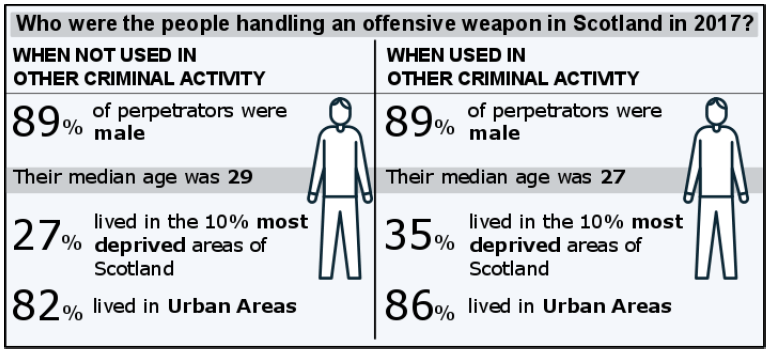
Characteristics of crimes of handling offensive weapons
Perpetrators
Weapon not used in other criminal activity
Where an offensive weapon wasn’t used in other criminal activity, the overwhelming majority of perpetrators in 2017 were male (89%) ( Table 2). This remained the case whether or not the weapon was a bladed or pointed article or a different type of offensive weapon.
The median age of perpetrators in 2017 was 29 years old ( Table 3). Individuals who were found in possession of a bladed or pointed article were slightly younger (28 years old) than those found in possession of an offensive weapon (30 years old). At 27 years old, the median age for perpetrators in 2013 was slightly lower than 2017.
A comparison of the samples drawn between 2013 and 2017 suggests there has been a significant change in the age profile of those who possess an offensive weapon. The percentage of those aged between 20 and 29 has fallen from 34% in 2013 to 24% in 2017, whilst those aged 40 or over increased from 19% to 25%. The percentage of perpetrators who were either teenagers (i.e. aged between 13 and 19) or aged between 30 and 39 remained similar between both years.
When the age profile of perpetrators is compared to Scotland’s population [12] ( Table 4), teenagers (i.e. aged between 13 and 19) made up almost a quarter (24%) of all perpetrators compared to 7% of the population (Chart 8). Individuals aged between 20 and 29 made up 24% of victims compared to 14% of the population. Individuals aged between 30 and 39 made up 22% of perpetrators compared to 13% of the population. Whereas those aged 40 or over made up a quarter (25%) of all perpetrators compared to over half (52%) of the population.
In general, the age profile of individuals who are found in possession of an offensive weapon is similar whether or not that weapon is a bladed or pointed article. However, perpetrators aged between 20 and 29 were more likely to be found in possession of a bladed or pointed article (28%) than an offensive weapon (18%).
Perpetrators are more likely than average to live in areas of higher deprivation (Chart 9). For example 27% of perpetrators lived in the 10% most deprived datazones in Scotland (which contain 10% of the population) whilst only 3% of perpetrators lived in the 10% least deprived areas of Scotland (which also contain 10% of the population).
At 82%, perpetrators of these crimes are more likely to reside in an urban area than the population as whole (70%). The remaining 18% of perpetrators live in either a small town (10%) or rural area (8%), both of which are lower than the percentage of the total population that lives there (13% and 17% respectively).
Weapon used in other criminal activity
Where an offensive weapon was used in other criminal activity against a person, the overwhelming majority of perpetrators in 2017 were also male (89%) ( Table 2). This remained the case whether or not the weapon was a bladed or pointed article or an offensive weapon.
The median age of perpetrators in 2017 was 27 years old. Individuals who committed crimes involving a bladed or pointed article were slightly older (28 years old) than those that involved an offensive weapon (25 years old). A quarter (25%) of perpetrators were teenagers (i.e. aged between 13 and 19). Almost a third (30%) were aged between 20 and 29 with a further 24% aged between 30 and 39 and a fifth (18%) were aged 40 or over.
In general, the age profile of individuals who are found in possession of an offensive weapon is similar whether or not that weapon is a bladed or pointed article. However, perpetrators aged between 30 and 39 were more likely to be found in possession of a bladed or pointed article (28%) than an offensive weapon (22%).
Chart 8: Percentage of perpetrators and victims against the share of the population in 2017, by age group.
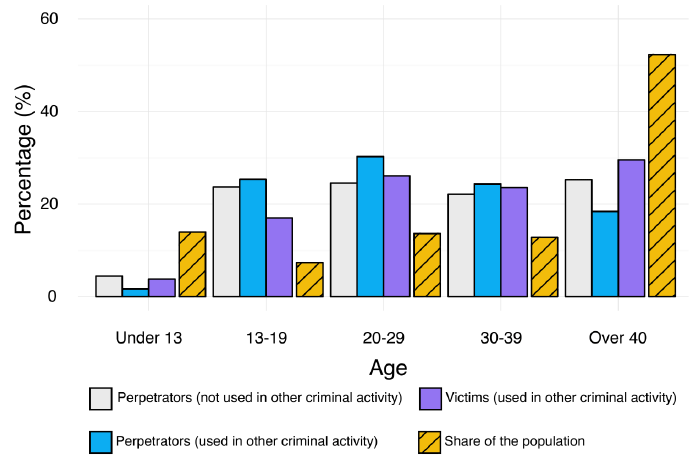
When the age profile of perpetrators is compared to Scotland’s population [13] ( Table 4), teenagers (i.e. aged between 13 and 19) made up a quarter (25%) of all perpetrators compared to 7% of the population (Chart 8). Individuals aged between 20 and 29 made up 30% of victims compared to 14% of the population. Individuals aged between 30 and 39 made up 24% of perpetrators compared to 13% of the population. Whereas those aged 40 or over made up a less than a fifth (18%) of all perpetrators compared to over half (52%) of the population.
Perpetrators of using weapons to commit other criminal activity were much more likely to live in areas of higher deprivation (Chart 9). For example 35% of perpetrators lived in the 10% most deprived datazones in Scotland, whilst only 1% of perpetrators lived in the 10% least deprived areas of Scotland.
At 86%, perpetrators of these crimes are more likely to reside in an urban area than the population as a whole (70%). The remaining 14% of perpetrators live in either a small town (8%) or rural area (6%), both of which are lower than the percentage of the population that live there (13% and 17% respectively).
Chart 9: Perpetrator location, by SIMD16 Decile and whether the weapon was used to commit another crime, April to September, 2017.
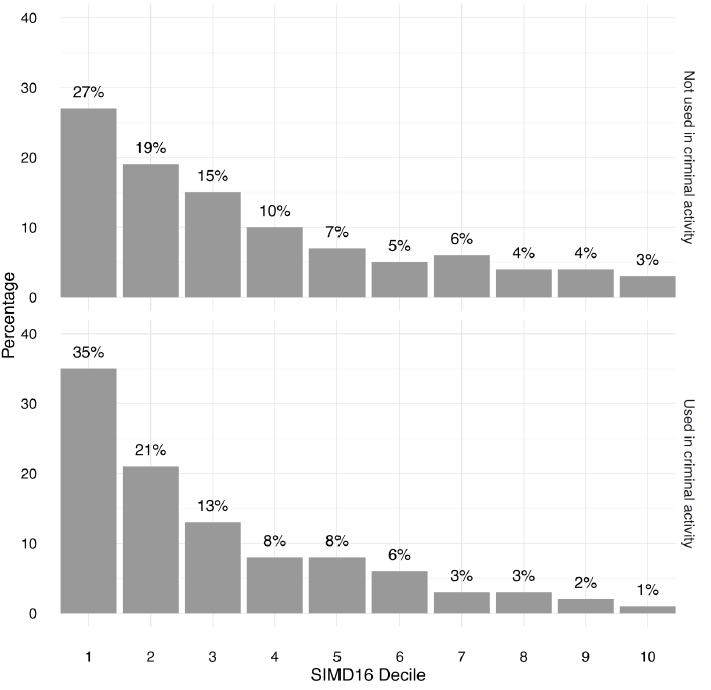
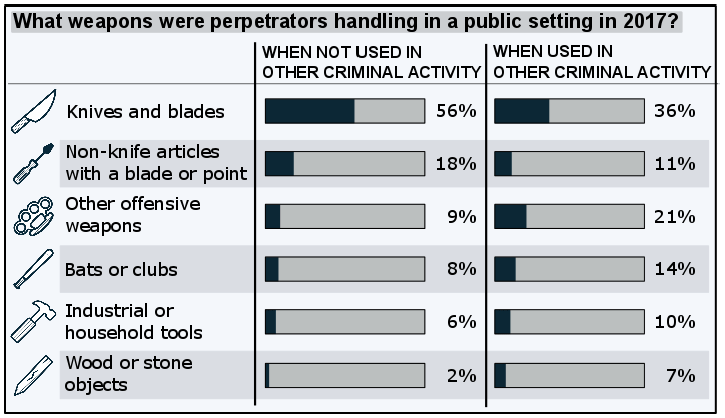
Weapons
Weapon not used in other criminal activity
When the weapon was not used in other criminal activity, over half of all weapons (56%) were knives and blades and almost a fifth (18%) were non-knife articles with a blade or point. Together these comprise three quarters (75%) of all weapons ( Table 5) a significant increase from two-thirds of all weapons (66%) in 2013.
Of the remaining weapons almost a tenth (9%) were other offensive weapons (there were frequent references to glass bottles and knuckledusters), 8% were bats or clubs, 6% were industrial or household tools and 2% were wooden or stone objects. Together these weapons comprise a quarter (25%) of all weapons found, a significant decrease from 34% in 2013.
The other offensive weapons category above includes cases where the weapon was an acid or other corrosive substance. Of the 500 crimes sampled in 2017 (where the weapon was not used in other criminal activity) two cases made reference to the perpetrator being in possession of a potentially corrosive substance.
Weapon used in other criminal activity
In 2017, when the weapon was used in other criminal activity, over a third (36%) of weapons were knives and blades and a tenth (11%) were non-knife articles with a blade or point ( Table 5). In total these make up almost half (48%) of all weapons, significantly lower than for when the weapon was not used in other criminal activity (75%).
Of the remaining weapons, over a fifth (21%) were other offensive weapons, 14% were bats or clubs, 10% were industrial or household tools and 7% were wooden or stone objects. Together these comprise over half (52%) of all weapons, significantly higher than for when the weapon was not used in other criminal activity (25%).
The other offensive weapons category above would have included cases where the weapon used in other criminal activity was an acid or other corrosive substance. However of the 500 crimes sampled in 2017, no cases involved this type of weapon
Reporting
Weapon not used in other criminal activity
There are a number of different ways in which crimes can be reported to the police. The way in which crimes came to the attention of the police was similar regardless of the weapon involved.
Where the weapon was not used to commit other criminal activity, the most common way in which crimes came to the attention of the police was when a witness reported the incident (46% in 2017). This was a significant increase on 2013 when 38% of crimes were witness reported ( Table 6). Over a quarter of reports (28%) came from police discovering the weapon possession while investigating another crime or incident. Police patrols accounted for 17% of all crimes recorded, a significant decrease compared to 2013 (25%).
Weapon used in other criminal activity
Where the weapon was used to commit a crime or offence against a person, the way this came to the attention of the police is different than where the weapon was not used ( Table 6). Reporting by the victim accounted for half (50%) of all crimes, with over a third (36%) reported by a witness. The remaining 15% is split almost equally across all the other reporting groups.
Location
Weapon not used in other criminal activity
In 2017, the majority of crimes (61%) where the weapon was not used in other criminal activity occurred in an open space (the majority of which were streets, footpaths and roads) ( Table 7). Crimes of possessing an offensive weapon are slightly more likely to occur in an open space (65%) compared with bladed or pointed articles (58%).
Sixteen per cent of these crimes occurred in a public or voluntary sector setting in 2017, a significant increase compared to 6% in 2013. This category includes, schools, prisons, police stations, medical centres and other public sector buildings, all of which had a higher volume recorded in 2017 compared with 2013.
Between 2013 and 2017, the proportion of possession of an offensive weapon that occurred in a school setting increased from 1% to 6% (compared to less than 1% in 2017 when the weapon was used in other criminal activity). However, this is based on a very small number of cases within the overall sample and should be treated with caution.
Fourteen per cent of these crimes took place in a dwelling-type setting (which includes gardens, common stairwells and other communal areas). The remaining 10% were split across either retail, night-time economy and other business or public transport settings.
The location of crimes where the weapon was not used in other criminal activity were skewed towards areas of higher deprivation (Chart 10). For example, 27% of crimes occurred in the 10% most deprived areas of Scotland whilst only 5% occurred in the 10% least deprived areas of Scotland. The clear majority of these crimes (82%) occurred in an urban area, with the remaining 18% split between small towns (10%) and rural areas (8%).
Weapon used in other criminal activity
In 2017, the majority of crimes (59%) where the weapon was used in the other criminal activity occurred in an open space (mostly streets, footpaths and roads) ( Table 7). Where the weapon was used, slightly more occurred in a dwelling-type setting (23%) compared to where the weapon was not used (14%). However, fewer cases occurred in a public or voluntary sector setting (4%) than when the weapon was not used (16%). A slightly larger proportion of crimes occurred in a retail setting than where the weapon was not used, 13% compared to 8%.
Where the weapon was used in other criminal activity the location was also skewed towards areas of higher deprivation, with 31% of crimes occurring in the 10% most deprived areas of Scotland, whilst only 3% occurred in the 10% least deprived areas of Scotland. The vast majority of these crimes (86%) occurred in an urban area, with the remaining 14% split between small towns (8%) and rural areas (6%).
Chart 10: Locus of crimes, by SIMD16 Decile and whether the weapon was used to commit another crime, April to September, 2017.
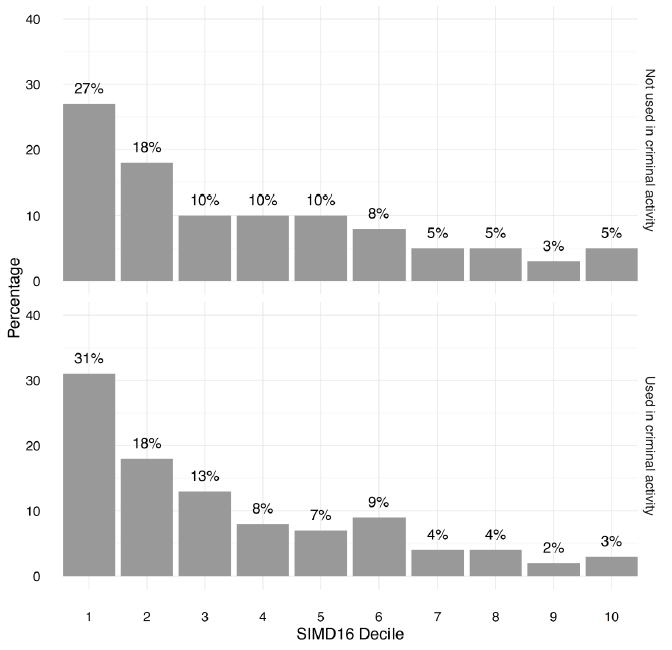
Day and time the crime was committed
Weapon not used in the commission of a crime
In 2017, almost two thirds (64%) of all crimes where the weapon was not used occurred between midday and midnight across the entire week ( Table 8), a similar proportion to the crimes in 2013. The weekend [14] accounted for over a third (35%) of these crimes in 2017, compared to almost half (47%) in 2013.
Weapon used in the commission of a crime
Almost three quarters (72%) of all crimes where the weapon was used to commit a crime or offence against a person occurred between midday and midnight ( Table 8). The weekend accounted for 44% of all these crimes.
Alcohol and drugs
Weapon not used in other criminal activity
A number of records make reference to the consumption of alcohol and/or drugs. This could be in reference to the perpetrator(s), the victim(s) or both. This doesn’t necessarily mean that it was a causal factor in these crimes. At the same time alcohol or drugs may have been consumed prior to some of these crimes taking place, but not referenced in the crime record.
In 2017, almost half (47%) of weapon possession crimes where the weapon had not been used in other criminal activity made reference to either alcohol and/or drugs ( Table 9). This breaks down into 25% alcohol, 18% drugs, and 4% both. The proportions in all cases were similar regardless of whether the crime involved an offensive weapon or a bladed or pointed article.
Weapon used in other criminal activity
When the weapon was used in other criminal activity, significantly less made reference to either alcohol and/or drugs than when the weapon was not used (39%). This breaks down into 31% alcohol, 5% drugs, 3% both ( Table 9).
The difference in the proportion of records that made reference to drugs between crimes where the weapon was and was not used could be due to the different ways in which these crimes come to the attention of the police. Significantly more crimes were discovered by officers on patrol when the weapon was not used (17%) than when it was (3%) and this in turn could relate to when a perpetrator is discovered to be in possession of an offensive weapon upon being searched under suspicion of being in possession of drugs.
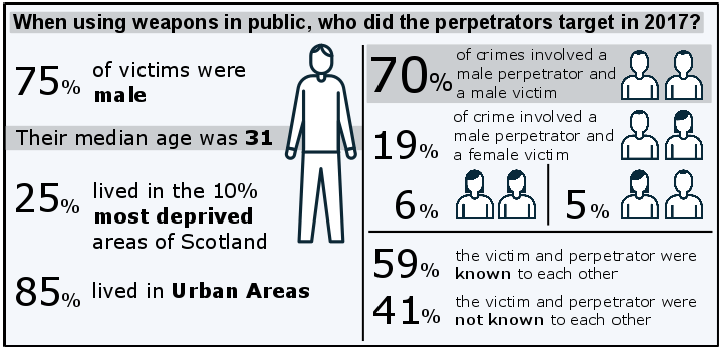
Characteristics of crimes committed against a person using an offensive weapon
This section provides commentary on the types of crimes that have been committed using a weapon in a public setting, along with the demographics of the victims of these crimes, and the nature of any physical injuries sustained as a result of the perpetatrators actions.
Victims
In 2017, when the weapon was used in other criminal activity, the majority of victims were male (75%) ( Table 4). When the crime involved an offensive weapon the proportion of male victims was slightly higher (78%) than for crimes involving a bladed or pointed article (70%).
The median age of all victims was 31 years old, and was similar regardless of the type of weapon used in the crime ( Table 11). Almost a fifth (17%) of all victims were teenagers (i.e. aged between 13 and 19). Over a quarter (26%) were aged between 20 and 29 with further 24% aged between 30 and 39 and 30% aged 40 or over.
Three out of the 500 records sampled involved a police officer as a victim. In each of these cases the perpetrator was in possession of an offensive weapon rather than a bladed or pointed article.
When the age profile of victims is compared to Scotland’s population [15] ( Table 4), individuals aged 13 to 19 (i.e. teenagers) made up 17% of all victims compared to 7% of the population (Chart 8). Individuals aged between 20 and 29 made up 26% of victims compared to 14% of the population. Individuals aged 30 to 39 made up 24% of victims compared to 13% of the population. Whereas individuals aged 40 or over made up almost a third (30%) of all victims compared to over half (52%) of the population.
In the majority of these crimes (70%), both the victim and the perpetrator were male ( Table 12). Just under a fifth (19%) involved a female victim and a male perpetrator. The remaining tenth was split into crimes where both the victim and perpetrator were female (6%) and where the victim was male and the perpetrator was female (5%).
For those crimes where both the perpetrator and the victim were male, 62% involved an offensive weapon and 38% involved a bladed or pointed article. Crimes that involved a male perpetrator and a female victim were equally likely to involve either an offensive weapon or a bladed or pointed article (50% for both).
Individuals who live in more deprived areas of Scotland were more likely to be victims of a weapon-based crime in a public setting than those who live in less deprived areas (Chart 11). For example, 25% of victims lived in the 10% most deprived areas of Scotland, whilst only 4% of victims lived in the 10% least deprived areas of Scotland.
The majority of victims (85%) lived in an urban area, compared with 70% of the population as a whole. The remaining 15% of victims reside in either a small town (9%) or a rural area (6%), both of which are lower than the percentage of the population that live there (13% and 17% respectively).
Chart 11: Victim locus, by SIMD16 Decile when the weapon was used to commit another crime, April to September, 2017.
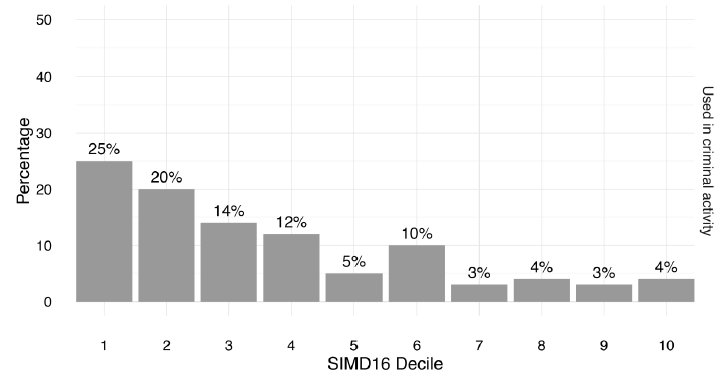
Relationship between victims and perpetrators
The definitions used to classify the relationship between victims and perpetrators (where both were identifiable) are shown below.
- Relative – this includes any parents, grandparents and siblings.
- Partner or ex-partner – where the victim and perpetrator were or had been in a relationship.
- Acquaintances – includes friends, neighbours, colleagues, class mates etc.
- Professional – this is primarily where the victim has come into contact with the perpetrator in a professional capacity. This includes where the victim was a police or prison officer, a nurse, carer, teacher, commercial staff etc. It also includes a small number of cases where the perpetrator is the ‘professional’ responsible for the victim.
- Strangers – this is where the perpetrator was not known to the victim prior to the crime.
In 2017, 59% of crimes where the weapon was used involved a perpetrator who was known to the victim ( Table 13). The most common relationship between the victim and perpetrator was an acquaintance (52% of all cases). One in twenty (5% of crimes) involved either a relative or a partner/ex-partner. In the remaining 41% of crimes the victim and perpetrator were not known to each other. In the vast majority of cases this is because they were strangers (39% of all cases sampled), though in a small number of cases the victim was a police officer or other professional (2%).
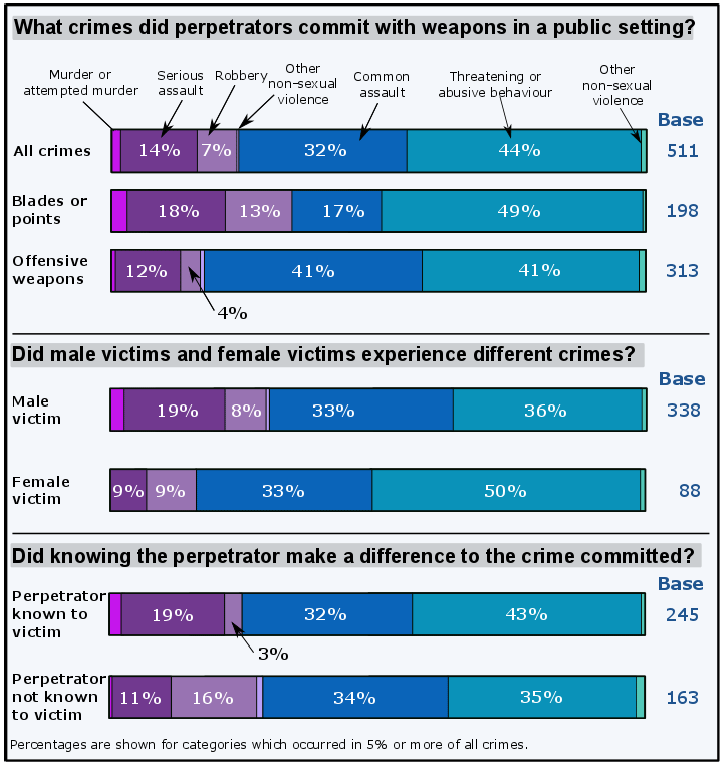
Crimes committed against a person
The most common crime committed against a person with a weapon is threatening or abusive behaviour (44%), followed by common assault (32%), and serious assault (14%) ( Table 14). The type of crime committed varied depending on the weapon being used. When the weapon was a bladed or pointed article, the most common crime it was used to commit was to threaten the victim (49%), a further 18% were serious assault, 17% common assault, 13% robbery and, 3% homicide/attempted murder. Offensive weapons were equally likely to have been used to threaten or commit a common assault (41% each). Offensive weapons are in general less likely to be used to commit more serious crimes with12% for serious assault and 4% for robbery.
When the victim was female they were more likely to be threatened (50%) than when the victim was male (36%). Males were more likely to be the victim of serious assault (19% compared with 7% for females). Common assaults were equally likely for male and female victims (33% each) and robberies were similar between males (8%) and female (9%) victims.
When the victim knew the perpetrator, they were more likely to be threatened (43%) than when the victim and the perpetrator were not known to each other (35%). Victims were also more likely to suffer a serious violent crime (including murder & attempted murder and serious assault) when they knew the perpetrator (22% compared to 12% when they did not know the perpetrator). Victims who did not know the perpetrator were more likely to be robbed (16%) compared to victims who did know the perpetrator (3%).
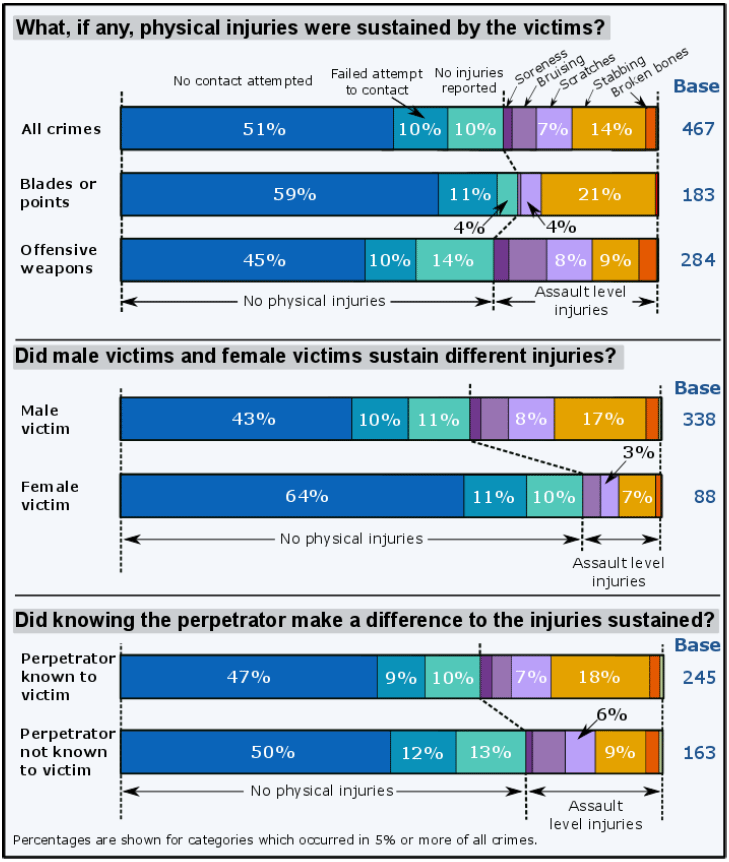
Physical injuries sustained by the victim
Over three fifths (61%) of crimes committed against a person involved no contact between the weapon and the victim ( Table 15) – either because no contact was attempted by the offender (51%) or any attempt to make contact failed (10%). This overall proportion was higher for crimes involving bladed or pointed articles (70%) than for those involving offensive weapons (55%). In a further 10% of crimes, contact with the victim was made but no physical injuries were reported (4% for blades or points, 14% for offensive weapons).
In the remaining 29% of crimes, there was some degree of physical injury sustained by the victim (26% for blades or points, 31% for offensive weapons). Blades or points were more likely to cause serious assault level injuries i.e. stab wounds or permanent disfigurement (21%). Whereas offensive weapons were more likely to cause a wider range of physical injuries including scratches, bruising, and soreness which combined made up 18% of injuries compared to 4% for blades or points.
When the victim was female, almost 9 in 10 crimes (85%) involved no physical injury to the victim, compared with almost two-thirds (64%) for male victims. For female victims, almost two-thirds (64%) involved no contact being attempted by the perpetrator, compared with almost half (43%) of male victims. Male victims were more likely to suffer a stabbing or permanent disfigurement (17%) than female victims (7%).
Crimes that resulted in no physical injury to the victim were more likely when the victim did not know the perpetrator (75%) than when they did (67%). Crimes that resulted in the victim suffering either a stabbing or permanent disfigurement were more likely when the victim knew the perpetrator (18%) compared with when they didn’t (9%).
Contact
There is a problem
Thanks for your feedback